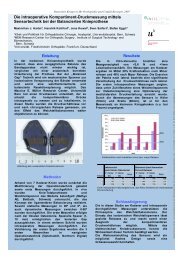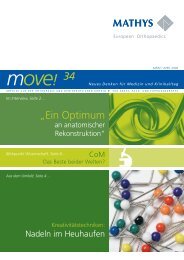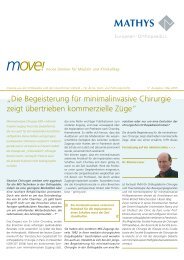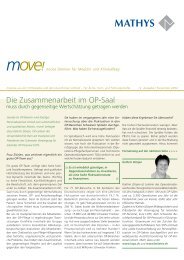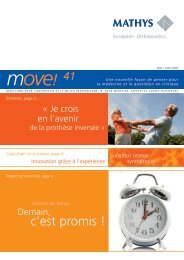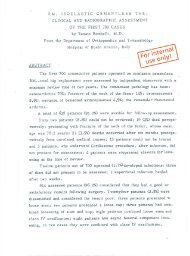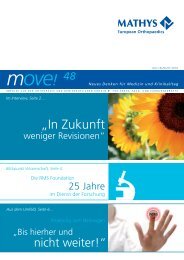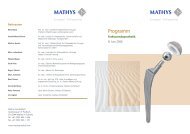You also want an ePaper? Increase the reach of your titles
YUMPU automatically turns print PDFs into web optimized ePapers that Google loves.
<strong>move</strong>! a new way of thinking about everyday life<br />
in medicine and in the clinic<br />
Stimuli from orthopaedics and the professional field – For physicians, specialists and executives<br />
“It‘s easy to implant<br />
and nothing ever goes wrong”<br />
The RM cup celebrates its 30th anniversary<br />
– reason enough to let our thoughts wander<br />
across to the distant New Zealand, where<br />
<strong>move</strong>! interviewed Professor Geoffrey Horne,<br />
a true expert when it comes to the tried and<br />
tested RM cup. We asked him about the idi-<br />
osyncrasies of the New Zealanders and the<br />
new developments in hip arthroplasties.<br />
Professor Horne, you have many years of<br />
experience with the RM cup. How many<br />
exactly and when do you implant it?<br />
I‘ve been using the RM cup now for over 24<br />
years, since 1981. I use it all the time actually,<br />
for all primary total endoprosthetic hip operations<br />
and for most revisions as well. For revisions<br />
I only use other cups in about 10 per cent<br />
of all cases – if there is a heavy loss of bone<br />
substance in the pelvis.<br />
At the beginning of the 1980s the cup didn‘t<br />
have a titanium coating. This caused problems<br />
on occasions. But in most cases it proved to be<br />
very stable, even in those days. As a matter of<br />
fact, I happen to have re<strong>move</strong>d two of these<br />
cups this morning. I implanted them in 1984.<br />
So, as you see, they have been doing a good<br />
job for more than 20 years, and since the day<br />
when the titanium-coated cup came onto the<br />
market, the results have simply been splendid.<br />
What exactly are the advantages of this<br />
cup?<br />
It‘s a very “forgiving” implant. It‘s easy to implant<br />
and nothing ever goes wrong. It can be<br />
used for all types of hips. It‘s extremely flexible.<br />
It hardly ever causes any trouble. Our studies<br />
show very pleasing survival rates – but you can<br />
expect that from a good polyethylene cup.<br />
Even more important: the cup doesn‘t cause<br />
osteolysis in the pelvis. Even after 10 or 15<br />
years there seems to be very little abrasion. You<br />
can‘t say that about every cup. It may be to<br />
do with the special polyethylene mixture that<br />
<strong>Mathys</strong> uses in manufacturing the cup. At any<br />
rate, that‘s a distinct advantage.<br />
»<br />
Here in New Zealand we‘re<br />
conservative in the most<br />
positive sense of the term<br />
On top of all this, the RM cup, being a monoblock<br />
implant, is relatively low-cost. This is<br />
good for the budgets of both my private<br />
patients and our public health system here in<br />
New Zealand. There‘s no evidence that the expensive,<br />
modular cups are even a jot better.<br />
What heads do you use with the cup?<br />
«<br />
Issue 21 / Nov./dec. 2005<br />
When I started to use it in the middle of the<br />
1980s there were some people who claimed<br />
that with ceramic on plastic there is less wear<br />
than with metal-plastic pairs. But you can use<br />
metal heads just as well with the RM cup.<br />
Here in New Zealand they are even a little bit<br />
cheaper. But I still use ceramic heads.<br />
Continued on next page > > ><br />
Professor Geoffrey Horn<br />
learned his orthopaedic skills In New Zealand<br />
and Canada. Today this hip and knee specialist<br />
is Professor for Surgery’ at the Wellington<br />
School of Medicine (Otago University) and a<br />
consultant and surgeon at Wakefield Hospital,<br />
Wellington‘s leading private clinic and the<br />
largest surgical establishment in central New<br />
Zealand.<br />
His scientific expertise is also uncontested – so<br />
far the former President of the New Zealand<br />
Orthopaedic Association (NZOA) has more than<br />
100 publications in international journals to<br />
his name.
Continuation<br />
Professor Horne, most of our readers don‘t<br />
think much about New Zealand. Is there<br />
anything that you would say are special<br />
New Zealand idiosyncrasies, a certain philosophy<br />
in endoprosthetics?<br />
As far as joint replacements are concerned, I<br />
think that we‘re somewhere between Europe<br />
and North America, although we tend to use<br />
more European makes rather than American<br />
or British ones. Far fewer ceramic components<br />
are implanted in this country – simply because<br />
they‘re very expensive. Here in New Zealand<br />
we‘re conservative in the most positive sense<br />
of the term. Most surgeons here stick to<br />
proven surgical techniques and implants for<br />
many years. Here we are less industry-driven<br />
than the Americans, for example, and only<br />
switch over to new techniques if this is good<br />
for our patients.<br />
A good example is crosslinked polyethylene;<br />
virtually no one in New Zealand uses it and<br />
I personally wouldn‘t implant it in any of my<br />
patients before I‘m convinced that the benefi<br />
ts outweigh the risks. So far there‘s been<br />
no evidence to prove that it behaves better in<br />
the body than traditional polyethylene. On the<br />
contrary, there‘s even reason to believe that<br />
it‘s more harmful due to the peculiarities of its<br />
abrasion particles.<br />
For your use<br />
Preventing percutaneous injuries<br />
By courtesy of<br />
Becton Dickinson GmbH<br />
The RM cup – 250.000 implanted worldwide<br />
Despite all your conservatism – where do<br />
you see new developments?<br />
Well, the trend world-wide is towards smaller<br />
accesses and therefore less traumatic surgery.<br />
The time spent in hospital as an in-patient is<br />
getting shorter all the time. Here in New Zealand<br />
as well, patients are sent home after 2 to<br />
3 days. Hip surgery is changing and continually<br />
developing. In my opinion, however, this<br />
evolution doesn‘t stem from the implants as,<br />
so far, there‘s no convincing evidence that the<br />
new product families are any better than the<br />
older ones.<br />
In Europe alone more than 200,000 percutaneous<br />
injuries from needles are registered<br />
every year and only 30 % of all incidents are reported<br />
at all. Becton Dickinson has developed<br />
a comprehensive range of safety products to<br />
prevent such injuries and the resulting risk of<br />
infection.<br />
The BD Eclipse safety injection device can<br />
be used for all the usual injections with Luer<br />
and Luer Lock syringes; after the skin has been<br />
punctured the integrated safety shield is easily<br />
activated with one hand; the cannula then irreversibly<br />
locks into the safety shield.<br />
Further safety products include blood sample<br />
sets, direct sample adapters for blood cultures,<br />
safety and incision lancets and peripheral<br />
vein access systems (IV therapy).<br />
I also think that there will be a development<br />
away from modular pressfi t cups with a metal<br />
back – simply because of the osteolysis problems<br />
that they cause. In the next few years<br />
we‘ll be seeing a sea change towards mono-<br />
block cups. This will certainly be diffi cult for<br />
the Americans, who see themselves as the<br />
inventors of modular pressfi t cups. But they<br />
won‘t be able to ignore the concerns about<br />
the greater backside wear, either. I think that<br />
the good clinical results of mono-block cups<br />
– including some results that we‘ll soon be<br />
publishing in America – will have an impact<br />
here as well.<br />
Thank you for this interview. __//<br />
Also available: EPINet (Exposure Prevention<br />
Information Network), a free software developed<br />
by the University of Virginia for the documentation<br />
of percutaneous injuries and cuts<br />
and to record all measures for post-exposure<br />
prophylaxis and all follow-up examinations.<br />
Becton Dickinson GmbH<br />
Tullastr. 8-12, D-69126 Heidelberg<br />
Telephone: +49 (0) 62 21- 3 05-0<br />
Fax: +49 (0) 62 21- 3 05-216<br />
More information at: www.mediaform.de<br />
and www.nadelstichverletzung.de
Focus on science<br />
The 30th anniversary of the RM cup:<br />
A modern classic in the shadow of Big Ben<br />
Welcome to London – <strong>Mathys</strong> had sent out the<br />
invitation and many came. Around 80 orthopaedic<br />
surgeons from 15 countries met in the<br />
old and venerable halls of the Royal Horseguard<br />
Hotel in the British metropolis in the middle of<br />
September in order to exchange their expertise<br />
and discuss current scientifi c fi ndings. The “star<br />
of the show“ was the replacement hip joint<br />
which has successfully provided service for 3<br />
decades: the RM cup.<br />
From the start most delegates had one thing<br />
in common. Their familiarity with an implant<br />
which was fi rst used clinically in 1975 and has<br />
since been used worldwide more than 250,000<br />
times. The hour of its birth actually goes back<br />
to the year 1967 when the Swiss engineer Robert<br />
<strong>Mathys</strong> developed his vision of a reinforced<br />
plastic implant which would be suitable for<br />
everyone and affordable.<br />
For two days 20 hip specialists from Europe,<br />
Latin America, Israel, Thailand and New Zealand<br />
presented the fi ndings of international studies<br />
and relevant reports based on experience of<br />
the RM cup. Those present were in agreement<br />
about one thing: the cement-free polyethylene<br />
cup is a modern classic which can still convince<br />
today because of its excellent results.<br />
96.7% survival rate after 15 years<br />
“It can be used for all types of hips. It‘s extremely<br />
fl exible. It hardly ever causes any trouble”,<br />
– this is how Prof. Horne of the Wakefi eld<br />
Hospital, New Zealand described it. A view<br />
shared by Dr Markku Yli-Jama from Mikkeli,<br />
Finland and his Russian colleague Dr Vladimir<br />
Danilyak. They divided the secret of the implant’s<br />
success into three important points:<br />
its elasticity in conformity with the acetabulum<br />
(1000N/mm 2 ),<br />
the mono-block design which is accompanied<br />
by a very strong PE coating and facilitates<br />
implantation without unnecessary bone loss in<br />
the pelvis, and<br />
The host: Robert <strong>Mathys</strong>, Hugo <strong>Mathys</strong><br />
its special titanium coating which ensures<br />
permanent anchoring in the bone without the<br />
risk of osteolysis.<br />
The reward is above average serviceable life.<br />
At the London Conference survival rates of<br />
96.7% after 15 years were announced for the<br />
TiCP coated RM cup. “The cup has stood the<br />
test of time”– this is how one of the participants<br />
in the conference accurately formulated<br />
it. At the end of the two-day symposium it was<br />
only a question of calling out to the experts<br />
present and especially the many wearers of the<br />
RM cup around the globe: Keep moving!
Familiar, personal and serious<br />
In addition to product quality and technical expertise the<br />
partnership between doctors and <strong>Mathys</strong> is defi ned by<br />
trust, the ability to communicate and the willingness to<br />
provide service. At least this is what the comments of the<br />
participants of the symposium in London verify.<br />
“<strong>Mathys</strong> stands out well from the large marketingdriven<br />
American manufacturers: familiar, personal and<br />
serious – just as it should be.”<br />
Dr Everth Merida Herrera, Mexico<br />
“I am an enthusiastic <strong>Mathys</strong> user – not as a local patriot<br />
but because of the products. The competence and<br />
the standard of care which I experience with <strong>Mathys</strong> is<br />
incomparable.”<br />
Dr Lukas Schatzmann, Switzerland<br />
“We are used to <strong>Mathys</strong>’ excellent service. But we are<br />
also excellent customers.”<br />
Dr Maarten Spruit, the Netherlands<br />
“With <strong>Mathys</strong> it is not merely a question of business.<br />
I have known the company personally for more than 25<br />
years and do not regard myself as a customer but more<br />
as a friend and part of a family.”<br />
Dr Suthorn Bavonratanavech, Thailand<br />
For your use<br />
Hippocrates:<br />
the ethics debate<br />
Outdated tradition or a valid code of morals?<br />
Today many physicians see the Hippocratic<br />
Oath as no more than a relic from an antiquated<br />
and overbearing approach to medical<br />
ethics. Steven Miles, on the other hand, in his<br />
new and interesting book, makes the effort<br />
to free the Hippocratic Oath from the dust of<br />
the centuries and points out its signifi cance for<br />
modern medicine in a different way.<br />
His intellectual approach: the Hippocratic<br />
Oath still lays down valid principles for the relationship<br />
between the physician, society and<br />
the individual patient.<br />
Each chapter looks at a passage of the Oath<br />
and discusses it from the point of view of a real<br />
medical case in modern times. Even the often<br />
quoted parts that prohibit “the use of lethal<br />
substances“ and “abortifacients“ are not seen<br />
as a maxim against euthanasia and abortion,<br />
but are put into a modern context, taking account<br />
of their original intention.<br />
The author is a practising internist, a pioneer<br />
in the fi eld of medical ethics and, as a committed<br />
health politician, has stood for election to<br />
the US Senate.<br />
The New England Journal of Medicine<br />
wrote: “Miles‘ interpretation of the Oath is<br />
enlightening“; recommendable for everyone<br />
in the medical profession who would like to<br />
refl ect on the historical background and the<br />
ethics of their profession.<br />
Steven H. Miles: Hippocratic Oath<br />
And The Ethics of Medicine<br />
Paperback, 232 pages<br />
Oxford University Press 2005<br />
Price: from 16.95 EUR / 19.95 USD<br />
ISBN: 0195188209<br />
More information at: www.oup.com
From the professional field<br />
Interior design at the hospital:<br />
Creating a place in which to get well<br />
The clinics of today are intended to be health centres, but the first impression already<br />
raises doubts. Many hospital buildings still come across as depressing, functional, cold,<br />
colourless and soulless. The framed colour prints in the corridors are like a feeble attempt<br />
at a cosmetic touch. These are the architectural burdens from the past, which are all the<br />
more serious today because we know that good architecture and interior design at a hos-<br />
pital have a positive effect on both the healing of the patients and the work of the staff.<br />
“People are often preoccupied with the<br />
thought of being ill,“ says Dr Rotraud Walden<br />
from the Psychological Institute at the University<br />
of Koblenz, describing the way people<br />
feel when they are in hospital. “You are under<br />
observation by physicians and nurses, you are<br />
in an alien environment, and you have to be<br />
considerate towards others.“ A homely atmosphere<br />
can do wonders in overcoming the feeling<br />
of unease. However, good architecture and<br />
interior design not only further the well-being<br />
of the patients, but also help visitors and hospital<br />
staff to feel at ease. Therefore they become<br />
a positive image factor for a hospital in an<br />
increasingly competitive environment. When<br />
new hospitals are built or existing hospitals<br />
are reconstructed, it is therefore increasingly a<br />
question of combining functional requirements<br />
and medical facilities with concepts for interior<br />
design that take account of the human aspect.<br />
Old buildings can also be made considerably<br />
more attractive, sometimes with only a few<br />
simple measures.<br />
Short routes: many hospitals have grown<br />
organically. In order to get to the diagnosis and<br />
treatment facilities, patients, staff and providers<br />
of transport services often have a long way<br />
to go. Moving the radiology department from<br />
the basement to the centre of the building, for<br />
example, is not only more considerate towards<br />
the patients, but also saves time and money. It<br />
is ideal in the interests of efficiency to arrange<br />
the departments along the lines of the medical<br />
workflow and the organisational routines as far<br />
as this is possible.<br />
Signs / guide systems: nothing is worse<br />
for a hospital than people not being able to<br />
find their way round. The signs should therefore<br />
be detailed and clear. Guide systems must<br />
“pick up“ patients and visitors at the entrance<br />
and lead them to where they want to go without<br />
any ambiguity. Colour coding for individual<br />
wards or facilities are more easily remembered<br />
than numbers or abbreviations. With guide<br />
systems you can also enforce the separation of<br />
routes for visitors, for patients who are independently<br />
mobile and for patients who cannot<br />
<strong>move</strong> around on their own. This makes it easier<br />
to transport patients around the hospital, for<br />
example.<br />
Light, air and colour: these are very important<br />
factors in creating a feeling of well-being.<br />
Climatic buffers in front of the windows,<br />
for example, ensure pleasant air and light conditions<br />
as well as acting as a sound insulator.<br />
There should be sufficient daylight wherever<br />
this is possible. Lights must be bright enough<br />
for examinations, but they should not dazzle.<br />
When furnishing patient rooms and common<br />
For further reading<br />
Robert Wischer, Hans-Ulrich Riethmüller:<br />
Zukunftsoffenes Krankenhaus<br />
– Ein Dialog zwischen Medizin und<br />
Architektur; Springer Verlag 2004, ISBN<br />
3211258949<br />
Antje Monz, Johan Monz: Design<br />
als Therapie – Raumgestaltung in Krankenhäusern,<br />
Kliniken, Sanatorien; Verlagsanstalt<br />
Alexander Koch 2001, ISBN<br />
3874226271<br />
rooms preference should be given to materials<br />
and colours that are natural and warm. Due<br />
to their well-known psychological effect, it is<br />
particularly important that colours are used to<br />
create effect at the clinic. Blue, for instance,<br />
has a calming effect, but it is also a cold colour,<br />
while yellow stimulates and produces a feeling<br />
of happiness and red has a strong invigorating<br />
effect, for example in places of <strong>move</strong>ment such<br />
as sports places, kitchens and stairways.<br />
Personal self-determination: patients do<br />
not like to feel that they are helplessly at the<br />
mercy of the hospital routines. They wish to<br />
take a personal influence on life at the hospital.<br />
This means that they should be able to adapt<br />
their rooms to their own personal needs. It<br />
should be possible for them to independently<br />
operate more of the things in their rooms (e.g.<br />
regulating the heating or setting the height of<br />
the bedside tables). They should be able to put<br />
up personal belongings like pictures. Television,<br />
radio, telephone and perhaps even an internet<br />
connection must be within easy reach from a<br />
patient‘s bed. In addition to their own bathrooms,<br />
it is essential that four-bed rooms also<br />
have an additional wash basin.<br />
Communicative rooms: the opportunity<br />
for communication and interaction increases<br />
the quality of life during a stay at the clinic.<br />
For this reason there should also be inviting<br />
common rooms outside the patient rooms with<br />
sitting areas or atriums where patients can get<br />
together and pass the time of day. In addition<br />
to the now obligatory kiosk, cafeteria, hairdresser<br />
and cash machine, other meaningful<br />
and attractive facilities could be created inside<br />
the clinic, such as a bookshop or an orthopaedics<br />
workshop.<br />
Richard L. Miller, Earl S. Swensson:<br />
Hospital and Healthcare Facility Design;<br />
W. W. Norton & Company 2002, ISBN<br />
0393730727<br />
Cynthia A. Leibrock: Design Details<br />
for Health - Making the Most of Interior<br />
Design‘s Healing Potential; Wiley 1999,<br />
ISBN 0471241946<br />
Janet R. Carpman, Myron A. Grant:<br />
Design That Cares - Planning Health<br />
Facilities for Patients and Visitors; Jossey-<br />
Bass 2001, ISBN 0787957399
Product in focus<br />
Metal sliding pair:<br />
1 million <strong>move</strong>ments, less than 0.002 mm of wear<br />
Increasingly high standards of quality and the growing number<br />
of young and active patients call for increasingly longer lifetimes<br />
for total hip replacements. Revisions as a result of wear should<br />
be avoided in long-term use. Materials scientists are paying<br />
more and more attention to what are known as hard pairs – including<br />
metal-metal articulations. (These allow an improvement<br />
in wear behaviour.)<br />
The chemical and physical stability of the<br />
surfaces of the implant have a lot to do with<br />
the success of an artificial hip joint. Articulating<br />
surfaces are therefore subject to stricter<br />
conditions as these are not only permanently<br />
in contact with the body medium, but also<br />
have contact surfaces with additional dynamic<br />
loads. As a material of choice for fully metallic<br />
sliding pairs, hot-worked cobalt alloys<br />
have quite rightly become the norm, as the<br />
fracture-tough basic material, consisting of a<br />
CoCrMo matrix combined with finely distributed,<br />
embedded carbides of extreme hardness,<br />
meets the unusually high requirements for the<br />
material forming an artificial joint. A closer<br />
look shows that various CoCrMo alloys with<br />
different characteristics are used in prosthetics,<br />
differences that mainly become apparent over<br />
the course of time.<br />
A simulator study jointly carried out by the<br />
independent Orthopaedic Research Laboratory<br />
in Los Angeles and the Dr h. c. Robert <strong>Mathys</strong><br />
Foundation in <strong>Bettlach</strong>, for instance, has confirmed<br />
the excellent tribological behaviour of<br />
the <strong>Mathys</strong> metal sliding pair. On the assumption<br />
that a hip joint in vivo is subjected to strain<br />
on average one million times each year, the<br />
CoCrMo sliding pair, on the ball side, has a<br />
linear wear of less than 0.002 millimetres per<br />
year (Fig.).<br />
Masthead<br />
Publisher:<br />
<strong>Mathys</strong> Ltd <strong>Bettlach</strong> • Güterstrasse 5 • 2544 <strong>Bettlach</strong> • Switzerland<br />
Telephone No.: +41 (0)32 644 1 497 • E-Mail: <strong>move</strong>@mathysmedical.com<br />
Editor responsible for the magazine:<br />
Regula Haag • Corporate and Market Communication • <strong>Mathys</strong> Ltd <strong>Bettlach</strong><br />
Concept and design:<br />
IFAM Institut für angewandte Marketing-Wissenschaften GmbH • D-40545 Düsseldorf<br />
linear wear [mm]<br />
0,012<br />
0,009<br />
0,006<br />
0,003<br />
0,000<br />
0 1 2 3 4 5<br />
load cycle [m.]<br />
Fig.: Linear wear of a <strong>Mathys</strong> metal sliding pair expressed as a function of<br />
the number of load cycles (90% serum solution, 1 Hz, load transfer (Paul),<br />
Lmax=2000 N)<br />
Tested in 1999 at LAOH (McKellop): “ ... wear rates among the lowest we have<br />
previously measured“. Tested in 2001 at CRITT: “ ... plaçant ce couple dans les<br />
meilleurs testés actuellement au CRITT“.<br />
Send for your free copy<br />
Showing the way:<br />
Your new design compass<br />
It looks back on a longer history than the RM cup.<br />
The compass was invented in Empire of China back<br />
in 271. In those days it consisted of a piece of Magneteisenstein,<br />
hanging on a thread and was known<br />
as the “Südweiser“. Fortunately, the compass now<br />
waiting for you to send for it at <strong>Mathys</strong> is brand<br />
new and somewhat more exclusive. It combines<br />
form and function and is not only an extraordinary<br />
accessory, but also a genuine aid in finding your<br />
way around. It will show you the way when you are<br />
out hiking or travelling, precisely and reliably.<br />
Send for your new design compass in the attractive Zinn box free of charge!<br />
Send the enclosed fax form to: +41 (0)32 644 1 460<br />
Or simply send an e-mail to: <strong>move</strong>@mathysmedical.com<br />
As long as supplies last!<br />
<strong>move</strong>! is published by <strong>Mathys</strong> Ltd <strong>Bettlach</strong><br />
– your competent partner for total endoprosthetic<br />
treatment in orthopaedics. With<br />
new, useful information, <strong>move</strong>! is addressed<br />
to specialists in orthopaedics and traumatology<br />
in hospitals and practices, as well as all<br />
specialist and management staff in the medical<br />
field, nursing staff and general management<br />
in hospitals. We would like to thank all<br />
of those who have helped us in realising the<br />
publication of <strong>move</strong>! by making individual<br />
contributions, or providing information and<br />
photographs. Do you have some news or<br />
tips about orthopaedics and or clinical practice<br />
for us? You would like to make your own<br />
contribution to <strong>move</strong>! We would be pleased<br />
to hear from you. Please use the enclosed fax<br />
form. Or, you can contact us directly by telephone<br />
or using email.




